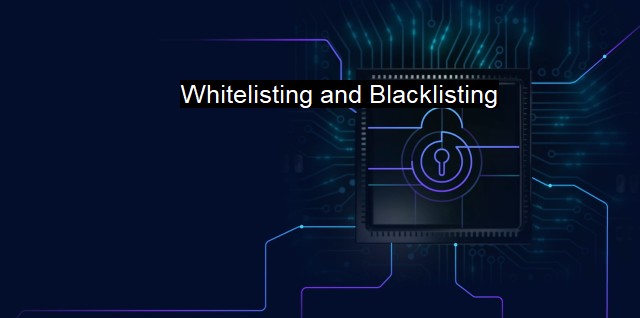What is Whitelisting and Blacklisting?
The Role of Whitelisting and Blacklisting in Cybersecurity Strategy: An Overview of the Key Techniques for Protecting Against Malware and Unauthorized Access
In the field of cybersecurity and antivirus systems, the concepts of whitelisting and blacklisting are crucial to understand and apply. They refer to two contrasting approaches used in enforcing security protocols in digital systems, devices and networks. Whitelisting and blacklisting seek to regulate access and filter out potentially harmful elements, but the specific tactics employed and outcomes achieved set the two apart.Whitelisting can be likened to the 'exclusive club' approach, which allows only specific validated entities to engage in an application or network. A whitelist contains an enumeration of approved entities that are authorized within a security policy and can be people, computers, networks, or other entities. When a system or network is configured to 'allowlist', it denies all access/activities by default and only grants approval to entities on the whitelist. This stringent approach is effective at excluding any unauthorized processes or software, theoretically minimizing cybersecurity risks.
For instance, antivirus programs often employ whitelisting to allow legitimate software to access computer resources while keeping out untrusted applications. They maintain lists of clean files that function on a user's device, avoiding false detections during system scans. Virus scans using whitelisting will only permit interactions from validated, trusted sources.
The chief drawback with whitelisting is its high maintenance requirement. The approver has to constantly update the list as new validated applications emerge, involves validation checks on new software to determine its trustworthiness, and at times, the approved activities need continual updating due to program upgrades. this practice may not fend off threats from previously proven entities that have since been compromised.
On the other side of the spectrum is blacklisting. Like a barred list at a venue, a blacklist contains entities that are deemed potentially harmful and are prohibited from accessing or running in a network or system. Antiviruses stick to the blacklist method, recognizing and restricting known threats, eliminating them from the system. Given the volume of new threats that can potentially invade a system, antivirus programs update their blacklists regularly in response, providing a form of proactive defense against known threats.
The strength of blacklisting lies in its simplicity and general applicability without dramatically affecting system usability. Any entity can operate freely until found suspicious or harmful and subsequently added to the blacklist. as this approach works chiefly on known threats, it leaves systems vulnerable to emerging threats or zero-day exploits - unknown malicious software that hasn’t yet been identified or analyzed, and hence, not on any blacklist.
To compose a reliable defense, both whitelisting and blacklisting should be deployed, based on their strengths and limitations. Whitelisting can be particularly appropriate whenever stringent containment is needed or where the possible operations and user interactions happen within a controlled and limited universe. Meanwhile, blacklisting can be helpful when dealing with vast data networks where exhaustive whitelisting would be complex or impractical.
Both whitelisting and blacklisting play an indispensable role in cybersecurity strategies, influencing the effectiveness of vulnerable systems and devices' protection from threats. They remain key tools for maintaining system integrity, user trust, and security in the digital sphere. They entail different types of policing: one that is preemptive, granting access only to trusted entities, and another focusing on reacting, banning recognized harmful entities from the system. By understanding these two methods and their particular assets and limitations, a secure and user-friendly environment can be achieved in the continuous battle against digital threats.

Whitelisting and Blacklisting FAQs
What is whitelisting and blacklisting in cybersecurity?
Whitelisting and blacklisting are two techniques used in cybersecurity to control access to resources such as websites, applications, or IP addresses. Whitelisting is a method of allowing only pre-approved sources or software to access a system or network, while blacklisting denies access to known unauthorized or malicious sources.How does whitelisting work in antivirus software?
Whitelisting in antivirus software involves creating a list of trusted files, applications, and websites that are allowed to run or access a system. This method provides protection against malware that is not on the whitelist while allowing safe programs to function without interruption.What are the advantages of using whitelisting over blacklisting in cybersecurity?
Whitelisting provides more effective and proactive protection than blacklisting. Because only pre-approved sources can access a system or network, it is much harder for attackers to exploit vulnerabilities or bypass security measures. Whitelisting also reduces false positives and eliminates the need for constant updating of blacklists.Can whitelisting be bypassed by attackers?
While whitelisting is a strong security measure, it can be bypassed by attackers who have access to the system or network. For example, an attacker could modify a legitimate program to include malicious code or hijack a trusted website to deploy malware. It is important to combine whitelisting with other security measures such as firewalls and intrusion detection systems to provide comprehensive protection against cyber threats.| | A | | | B | | | C | | | D | | | E | | | F | | | G | | | H | | | I | | | J | | | K | | | L | | | M | |
| | N | | | O | | | P | | | Q | | | R | | | S | | | T | | | U | | | V | | | W | | | X | | | Y | | | Z | |
| | 1 | | | 2 | | | 3 | | | 4 | | | 7 | | | 8 | | |||||||